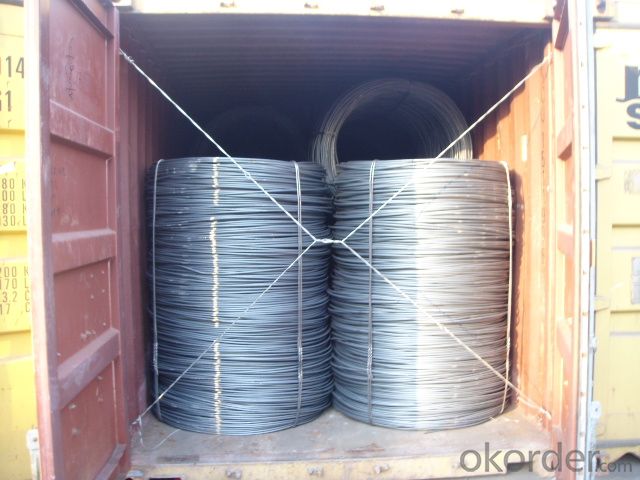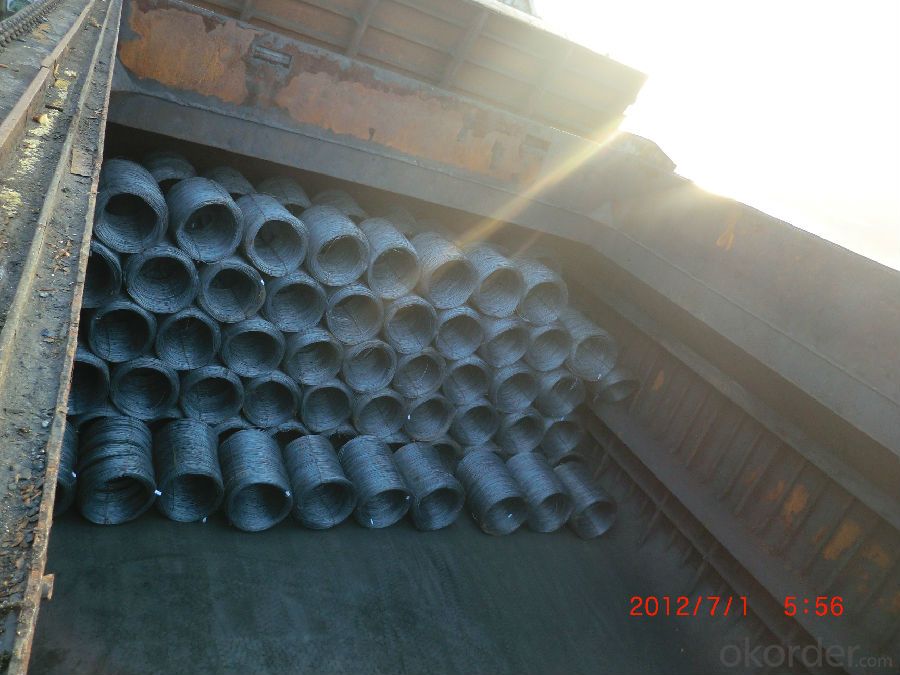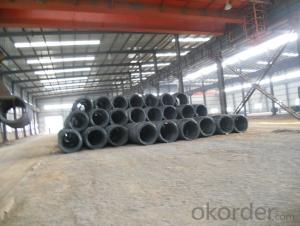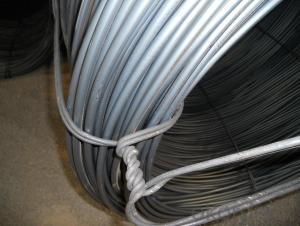ASTM Steel Wire Rods SAE1008,SAE1010, SAE1012
- Loading Port:
- Shanghai
- Payment Terms:
- TT or LC
- Min Order Qty:
- 25 m.t.
- Supply Capability:
- 200000 m.t./month
OKorder Service Pledge
OKorder Financial Service
You Might Also Like
Product Description:
OKorder is offering ASTM Steel Wire Rods SAE1008,SAE1010, SAE1012 at great prices with worldwide shipping. Our supplier is a world-class manufacturer of steel, with our products utilized the world over. OKorder annually supplies products to European, North American and Asian markets. We provide quotations within 24 hours of receiving an inquiry and guarantee competitive prices.
Product Applications:
After hot-rolled the products shaped into coil and delivery as finished product, including round, square,rectangular, hexagonal and so on. Since most of the products are round, it is generally called wire rod. Carbon steel wire rod is widely used in construction and manufacturing. Carbon steel wire rod is mainly used for reinforcement of reinforced concrete and welded structure or reprocessed (roberts , nail, etc.) materials, especially used to produce wire drawing, welding electrode, nails, spring, electronic, precise machinery parts and so on.
Product Advantages:
OKorder's ASTM Steel Wire Rods SAE1008,SAE1010, SAE1012 are durable, strong, and resist corrosion.
Main Product Features:
· Premium quality
· Prompt delivery & seaworthy packing (30 days after receiving deposit)
· Corrosion resistance
· Can be recycled and reused
· Mill test certification
· Professional Service
· Competitive pricing
Product Specifications:
ASTM Steel Wire Rods SAE1008,SAE1010, SAE1012
Grade: SAE1006-SAE1018
Certificates: ISO, SGS, BV, CIQ
Packaging: Export packing, nude packing, in coils
Grade | Chemical Composition (%) | |||||
C | Mn | S | P | Si | B | |
SAE1008B | 0.10max | 0.32max | 0.045max | 0.040max | 0.30max | 0.0008min |
Mechanical properties | ||||||
Yield strength(N/mm2) | Tensile strength(N/mm2) | Elongation (%) | ||||
≥195 | 350-380 | ≥32 | ||||
FAQ:
Q1: Why buy Materials & Equipment from OKorder.com?
A1: All products offered byOKorder.com are carefully selected from China's most reliable manufacturing enterprises. Through its ISO certifications, OKorder.com adheres to the highest standards and a commitment to supply chain safety and customer satisfaction.
Q2: How do we guarantee the quality of our products?
A2: We have established an advanced quality management system which conducts strict quality tests at every step, from raw materials to the final product. At the same time, we provide extensive follow-up service assurances as required.
Q3: The products are invoicing on theoritical weight or on actual weight?
A3: Usually, on actual weight.


- Q:How is steel wire rod recycled or disposed of?
- Steel wire rod can be recycled through a process called steel melting, where it is melted down and transformed into new steel products. Alternatively, if the wire rod is no longer suitable for recycling, it can be disposed of in landfills or sent to scrap metal yards for proper disposal.
- Q:Can steel wire rod be used in the production of reinforcing bars?
- Steel wire rod has the ability to be utilized in the manufacturing of reinforcing bars, commonly referred to as rebar. These rebar are crucial for fortifying and reinforcing concrete structures, such as buildings, bridges, and highways. Steel wire rod serves as a raw material during the manufacturing process of rebar. Typically, this wire rod is composed of top-notch steel and is drawn into the desired thickness and shape to meet the specific requirements of reinforcing bars. By doing so, it furnishes the necessary strength and durability needed to enhance the structural integrity of concrete, thus preventing any potential cracking or failure. Consequently, steel wire rod stands as an essential element in the production of reinforcing bars.
- Q:How are steel wire rods used in the construction of bridges?
- Steel wire rods serve various purposes in the construction of bridges. One common application is their use as reinforcement in concrete structures. Referred to as rebars, these steel wire rods are placed inside the concrete to enhance the bridge's durability and provide tensile strength. This is crucial as bridges must endure heavy loads, harsh weather, and potential seismic events. Additionally, suspension bridges also utilize steel wire rods. In these bridges, the primary load-bearing component is the cables, which are usually made from tightly wound strands of steel wire rods. The high tensile strength of these rods allows the cables to support the bridge deck's weight, ensuring its stability and safety. Furthermore, steel wire rods are employed in the fabrication of bridge cables for cable-stayed bridges. In this type of bridge, the cables are attached to the deck and anchored to the ground or supporting towers. The steel wire rods are arranged in a specific pattern to form the cable system, providing the necessary strength and stability to the bridge. These cables are essential for transmitting the loads from the bridge deck to the supporting elements, enabling the bridge to span long distances. In summary, steel wire rods are vital in bridge construction, providing reinforcement, enhancing tensile strength, and forming load-bearing cables. Their durability and ability to withstand heavy loads make them an ideal choice for ensuring the structural integrity and longevity of bridges.
- Q:How is steel wire rod tested for quality?
- Steel wire rod is tested for quality through a series of rigorous procedures to ensure its strength, durability, and adherence to industry standards. These tests typically include analyzing the chemical composition, conducting mechanical tests such as tensile strength and elongation measurements, inspecting the surface quality for any defects or imperfections, and verifying dimensional accuracy. Additionally, steel wire rod may also undergo tests for resistance to corrosion, heat treatment suitability, and adherence to specific international or customer-specific specifications. Overall, these comprehensive quality tests help ensure that only high-quality steel wire rods are released to the market.
- Q:How does the diameter of steel wire rod affect its strength?
- The diameter of a steel wire rod directly affects its strength. Generally, a larger diameter wire rod will have higher strength compared to a smaller diameter wire rod. This is because a larger diameter rod has a greater cross-sectional area, allowing it to withstand higher loads and stresses without breaking or deforming.
- Q:How are steel wire rods used in the production of wire cables?
- Steel wire rods are used as the primary raw material in the production of wire cables. These rods are first drawn through a series of dies to reduce their diameter and increase their length, resulting in steel wires of varying thicknesses. Multiple steel wires are then twisted or braided together to form wire strands. These strands are further combined and coated with protective materials to create wire cables of different strengths and functionalities, which are extensively used in various industries such as construction, telecommunications, and transportation.
- Q:How is steel wire rod used in the manufacturing of wire for automotive seat belts?
- Steel wire rod plays a crucial role in manufacturing wire for automotive seat belts, as it possesses exceptional strength and durability. Through a series of processes, the wire rod undergoes a transformation into the final wire used in seat belts. To begin, careful selection of the steel wire rod is conducted based on its specific properties, such as tensile strength and flexibility. Typically made from high-carbon steel, the rod is designed to endure the intense forces experienced during accidents. Subsequently, the selected steel wire rod is subjected to a process known as cold drawing. This process involves reducing the rod's diameter by pulling it through a series of dies, resulting in a thinner and more uniform wire. Cold drawing enhances the wire's strength and improves its surface finish. After cold drawing, the wire is commonly coated with a layer of zinc via galvanization. This coating acts as a protective barrier against corrosion, ensuring the wire remains resilient and reliable over time, even in harsh environments. The coated wire is then further processed to meet the specific requirements of automotive seat belts. Typically, it is wound onto spools or bobbins, ready to be fed into seat belt manufacturing machines. During the seat belt assembly process, the wire is cut to the desired length and threaded through the seat belt webbing. This wire provides the necessary strength and support to the seat belt, effectively restraining passengers during sudden stops or accidents. Overall, the utilization of steel wire rod in the manufacturing of wire for automotive seat belts plays a critical role in ensuring the safety and reliability of these vital safety devices. The steel wire rod's exceptional strength, durability, and resistance to corrosion make it an ideal material for seat belt production, providing peace of mind to manufacturers and consumers alike.
- Q:How does steel wire rod compare to other materials for wire production?
- Steel wire rod is widely regarded as one of the most suitable materials for wire production due to its exceptional strength, durability, and versatility. Compared to other materials, such as aluminum or copper, steel wire rod offers superior tensile strength and resistance to corrosion, making it ideal for various applications. Additionally, steel wire rod can be easily shaped, welded, and drawn into different wire sizes and forms, ensuring its compatibility with diverse industries like construction, automotive, and manufacturing. Its cost-effectiveness and widespread availability further contribute to its preference over other materials in wire production.
- Q:What are the different rolling processes used for steel wire rod production?
- There are several different rolling processes used for steel wire rod production, including hot rolling, cold rolling, and intermediate rolling. Hot rolling involves heating the steel billets to a high temperature and then passing them through a series of rollers to reduce their thickness and shape them into wire rods. Cold rolling, on the other hand, is done at room temperature and involves passing the wire rod through a series of rollers to further reduce its thickness and improve its surface finish. Intermediate rolling is a combination of hot and cold rolling and is used to achieve specific properties and dimensions in the wire rod.
- Q:What are the major players in the global steel wire rod market?
- The major players in the global steel wire rod market include ArcelorMittal, Nippon Steel Corporation, Tata Steel Ltd., POSCO, JFE Steel Corporation, Nucor Corporation, Steel Authority of India Limited (SAIL), EVRAZ plc, Gerdau S.A., and Sohar Steel LLC. These companies are leading manufacturers and suppliers of steel wire rod, which is widely used in various industries such as construction, automotive, and manufacturing. They have a strong presence in key markets across the globe and have a significant share in the global steel wire rod market. These major players often invest in research and development to develop innovative products and improve their production processes, ensuring their competitiveness in the market. They also focus on strategic partnerships, acquisitions, and expansions to expand their market reach and strengthen their position in the global steel wire rod market.
1. Manufacturer Overview |
|
|---|---|
| Location | |
| Year Established | |
| Annual Output Value | |
| Main Markets | |
| Company Certifications | |
2. Manufacturer Certificates |
|
|---|---|
| a) Certification Name | |
| Range | |
| Reference | |
| Validity Period | |
3. Manufacturer Capability |
|
|---|---|
| a)Trade Capacity | |
| Nearest Port | |
| Export Percentage | |
| No.of Employees in Trade Department | |
| Language Spoken: | |
| b)Factory Information | |
| Factory Size: | |
| No. of Production Lines | |
| Contract Manufacturing | |
| Product Price Range | |
Send your message to us
ASTM Steel Wire Rods SAE1008,SAE1010, SAE1012
- Loading Port:
- Shanghai
- Payment Terms:
- TT or LC
- Min Order Qty:
- 25 m.t.
- Supply Capability:
- 200000 m.t./month
OKorder Service Pledge
OKorder Financial Service
Similar products
New products
Hot products
Hot Searches
Related keywords




























